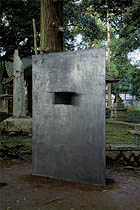
| CAREER | 1959 Born in Toyama, JAPAN 1985 Graduated from of Musashino Art University 1989 Graduated from National Art University of Munich, GERMANY PERSONAL EXHIBITIONS: 2004 Gallery Now, Toyama (’01/ ’92/ ’90) 2001 Kaneko Art Gallery, Tokyo (’00) 1996 Gallery An Adan, Ibaraki 1994 Konishi Gallery, Kyoto (’92) 1998 Gallery Moc, GERMANY SELECTED GROUP EXHIBITIONS: 2003 The 5th Exhibition of Amabiki Village and Sculpture. Yamato, Ibaraki (’01/ ’99/ ’97-’98) The Sculpture2003. Toyama 1995 The Selected Exhibition of North Japan. Toyama 1991 The Art of Toyama ’91. The Museum of Modern Art Toyama, Toyama 1990 The Space Art Toyama. Toyama 1988 The Academy Art Festival. GERMANY SYMPOSIUMS: 1998 Artists’ Camp in Kasama. Ibaraki (’97/ ’96/ ’95/ ’94) 1991 Georgia International Sculpture Camp. GEORGIA 1989 India-Japan Sculptor’s Camp. Vadodara, INDIA 1987 Kuroshima International Symposium. Nagasaki |
















